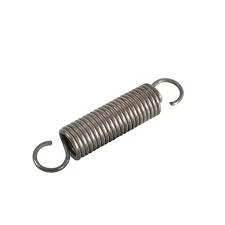
- Mobile Phone
- +8613931874955
- sales@cntcmetal.com
Understanding Helical Compression Mechanics in Engineering Applications and Design Considerations
Helical Compression Understanding the Mechanics and Applications
Helical compression springs are a fascinating and versatile component in mechanical engineering, widely used across various industries. Their unique design and functionality stem from the principles of compression and helical geometry, making them essential in applications ranging from automotive systems to aerospace technologies.
The Basics of Helical Compression Springs
A helical compression spring is typically made from high-carbon steel or stainless steel, coiled into a spiral shape. This design allows the spring to store mechanical energy when compressed. The characteristics of a helical spring, such as its diameter, wire thickness, and the number of coils, determine its load-bearing capacity and spring rate. The spring rate is a critical parameter, defined as the amount of force required to compress or extend the spring by a unit length. Understanding this property is essential for engineers when selecting the appropriate spring for a specific application.
One of the fundamental principles governing helical compression springs is Hooke’s Law, which states that the force exerted by a spring is proportional to its displacement. This relationship provides a predictable model for how these springs behave under load, making them reliable components in many mechanical systems.
Manufacturing Process
The manufacturing of helical compression springs involves several steps, including designing, material selection, wire forming, heat treatment, and surface finishing. Modern manufacturing technologies, such as CNC (Computer Numerical Control) machining, allow for precise control over the dimensions and mechanical properties of springs. Heat treatment is particularly crucial as it enhances the strength and durability of the spring, ensuring it can withstand repeated cycles of compression and extension without deformation or failure.
Applications of Helical Compression Springs
helical compression

Helical compression springs are utilized in numerous applications, reflecting their adaptability. In the automotive industry, for instance, they can be found in shock absorbers, clutch assemblies, and suspension systems, where they play a crucial role in absorbing shocks and maintaining vehicle stability. Similarly, in appliances like washing machines and refrigerators, these springs provide essential counterbalancing and support mechanisms.
In the aerospace sector, helical compression springs contribute to the functionality of landing gear and cargo mechanisms, where reliability under extreme conditions is paramount. The medical industry also benefits from these springs; they are often found in devices like surgical instruments and prosthetics, where precision and performance are critical.
Challenges and Innovations
Despite their many advantages, helical compression springs face challenges such as fatigue failure and corrosion. To combat these issues, researchers and engineers are constantly exploring new materials and coatings that enhance the performance and lifespan of springs. Innovations in smart materials and composite technologies are paving the way for next-generation springs that can adapt to changing loads and operational conditions.
Moreover, advancements in additive manufacturing (3D printing) are revolutionizing the production of complex spring geometries that were previously impossible with traditional manufacturing techniques. This technology allows for rapid prototyping and customization, providing new opportunities for innovation in design and functionality.
Conclusion
In summary, helical compression springs are a vital component in many mechanical systems, offering a blend of functionality and reliability. Their design, manufacturing processes, and diverse applications illustrate their significance in industries ranging from automotive to aerospace. As new materials and technologies emerge, the future of helical compression springs promises even greater efficiency and adaptability, ensuring they remain an indispensable part of modern engineering. Whether it's providing comfort in a vehicle or ensuring precision in medical devices, helical compression springs will continue to play a crucial role in advancing technology and enhancing everyday life.
share:
-
Wall Ties for Concrete: Invisible Guardians of Building Structural StabilityNewsAug.08,2025
-
Timber Frame Wall Ties: Stable Bonds for Load TransmissionNewsAug.08,2025
-
Stainless Steel Woven Wire Mesh: A versatile material from boundary protection to functional supportNewsAug.08,2025
-
Powder Coat Coil Springs: Creating peace of mind and reliability with sturdy protectionNewsAug.08,2025
-
Floor Standing Sign Holder: A Powerful Assistant for Flexible DisplayNewsAug.08,2025
-
Binding Iron Wire: An Invisible Bond for Building StabilityNewsAug.08,2025
-
Yard Sign Stakes: Reliable Guardians of Outdoor SignsNewsAug.04,2025



















